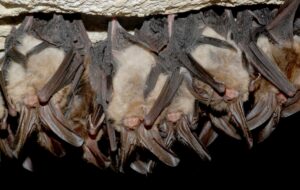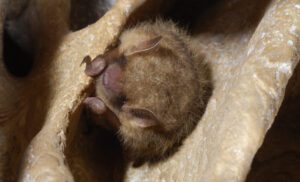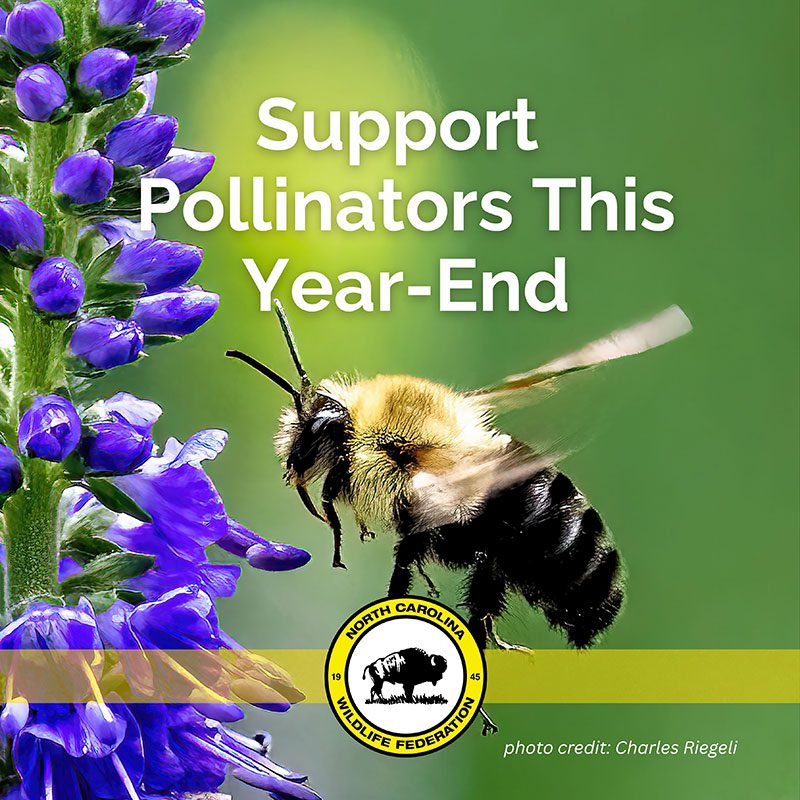Batty about BATS – Exploring & Protecting North Carolina Bat Species
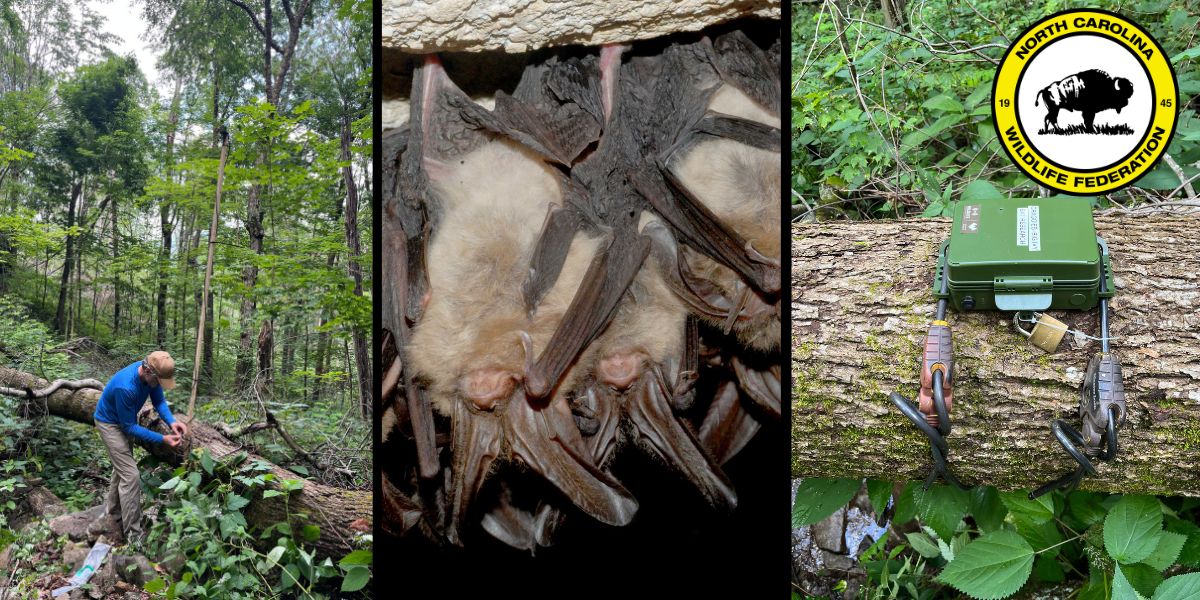
Bats are incredibly diverse and ecologically important creatures despite their reputation as being spooky or dangerous. They are
often misunderstood and misrepresented in popular culture. To start, let’s debunk four common myths about Bats according to Bat Conservation International.
Myth-Busting Bats
MYTH: All bats drink blood.
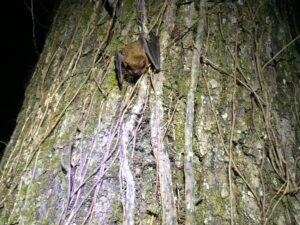
Photo: Big brown bat (Eptesicus fuscus) by Andrea Shipley, USFWS
FACT: Out of over 1,400 species of bats that exist worldwide, only three species of vampire bats feed on blood. These bats (located in Mexico, Central America, and South America) will rarely feed on human blood. Instead opting for livestock like cows and pigs, or on wild mammals and birds.
MYTH: Bats are Blind.
FACT: Bats have functional eyesight and some of the larger, fruit-eating bats can see three times better than humans. Some bats use echolocation as a way to “see” obstacles and catch prey in low light conditions, like dawn to dusk.
MYTH: All bats are rabid.
FACT: Less than 1% of bats have rabies; however, it is important to remember that bats can become infected and to use caution when you encounter one. Any potential contact with bat saliva, such as a bite or scratch, should be reported to a public health professional. Rabies is 100% preventable with proper medical care following exposure.
MYTH: Bats are Just Mice with Wings.
FACT: Bats belong to a completely different Order of animal (chiroptera) than mice or rats (rodentia). Bats are extremely long-lived for their size. Some bats can live up to 35 years, compared to rats that live for 1-2 years. Furthermore, female bats only give birth to one “pup” per year whereas rats give birth to many offspring, multiple times per year.
Bats of North Carolina
According to the N.C. Wildlife Resources Commission, North Carolina is home to 17 species of bats, including the federally-
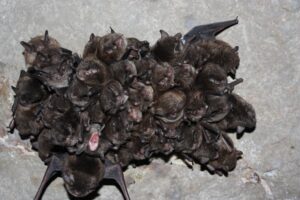
Photo: Indiana bats (Myotis sodalis) by Andrew King, USFWS
endangered Virginia big-eared bat, Indiana bat, gray bat, and the northern long-eared bat along with numerous species that are listed as a Species of Greatest Conservation Need (SGCN).
Like us, bats give birth to live young. They are relatively long-lived mammals and can survive 20 to 30 years in the wild and are primarily nocturnal, though they also forage in the early evening and early morning hours. Although most bats have relatively good eyesight, they primarily use echolocation to navigate and locate prey.
Bats mate in the spring or fall and usually produce one pup per year. Many species form maternity colonies in the summer to raise their young, while others are solitary roosters. In North Carolina, bats utilize a variety of habitats including forests, caves, mines, buildings, and even artificial structures like bat houses. They roost in hollow trees, behind loose bark, and in crevices of both live and dead trees. Bats also form colonies in human-made structures like attics and barns.
Some bat species migrate south for the winter and others find local hibernation areas, called hibernacula, for the winter. Bats prefer caves or mines for hibernacula, though they have also been known to use buildings and bridges, and they usually return to the same site every year.
List of North Carolina Bat Species
- Virginia Big-eared Bat (Corynorhinus townsendii virginianus) – SGCN, Federally Endangered
- Gray Bat (Myotis grisescens) – SGCN, Federally Endangered
- Northern Long-eared Bat (Myotis septentrionalis) – SGCN, Federally Endangered
- Indiana Bat (Myotis sodalis) – SGCN, Federally Endangered

Photo: Virginia bat (Corynorhinus townsendii virginianus) by Craig Sithler, USFWS
- Tricolored Bat (Perimyotis subflavus) – SGCN, “At Risk” – Under Federal Review
- Little Brown Bat (Myotis lucifugus) – SGCN, “At Risk” – Under Federal Review
- Rafinesque’s Big-eared Bat – Mountain Population (Corynorhinus rafinesquii rafinesquii) – SGCN
- Rafinesque’s Big-eared Bat – Central Piedmont Population (Corynorhinus rafinesquii macrotis) – SGCN
- Hoary Bat (Lasiurus cinereus) – SGCN
- Northern Yellow Bat (Lasiurus intermedius) – SGCN
- Southeastern Bat (Myotis austroriparius) – SGCN
- Eastern Small-footed Bat (Myotis leibii) – SGCN
- Big Brown Bat (Eptesicus fuscus)
- Silver-haired Bat (Lasionycteris noctivagans)
- Eastern Red Bat (Lasiurus borealis)
- Seminole Bat (Lasiurus seminolus)
- Evening Bat (Nycticeius humeralis)
The Benefits of Bats
Seed and Pollen Dispersal: Bats are integral to ecosystems worldwide. Tropical bats disperse large amounts of seed and pollen, enabling plant reproduction and forest regrowth, and are especially important in the pollination of cocoa, mango, and
the agave plant, which is used to produce tequila.
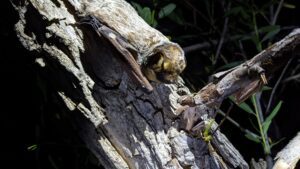
Photo: Hoary bat (Lasiurus cinereus) by Erin Lynch, NPS
Insect Control: North American bats have a major impact on controlling insect populations that are considered agricultural pests. They save the corn industry over $1 billion annually in pest control. A nursing female bat may consume almost her entire body weight in insects in a night.
Bat Guano (poop) Supports Cave Ecosystems: Caves are complex and unique ecosystems that provide homes for a diversity of creatures from insects to amphibians and fish as well as mammals. Many of these creatures rely on nutrients carried into the cave by water or other animals. Bat guano provides nutrients and supports cave ecosystems.
Bats are Prey for Other Animals: Just as some bats rely on thousands of insects each night for survival, other animals in the ecosystem rely on bats for their calories. Hawks, falcons, and owls eat bats. Mammals like weasels and raccoons sometimes attack bats while they roost.
Threats to Bats
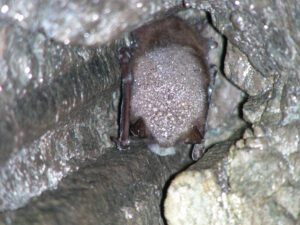
Photo: Little brown bat (Myotis lucifugus) with White Nose Virus by Marvin Moriarty, USFWS
Many bat species in the United States have declined in recent years. Pesticides, persecution, habitat loss, and human disturbance of hibernacula and maternity colonies have all likely contributed to this decline. Furthermore, an emergent fungal disease called white-nose syndrome (WNS) has killed more than six million bats since its discovery in New York in 2006. This disease spread to North Carolina in 2011, and continues to spread to new states each winter.
Conservation in Action
Many bat species in North Carolina are undergoing drastic population declines. Of the 17 species of bats listed above, four are federally endangered and 12 are identified as Species of Greatest Conservation Need. Many of these species – including the federally endangered gray, Indiana, northern long-eared, and Virginia big-eared bats rely on mature, intact forests for roosting and foraging. This habitat is especially important to bat populations as they contend with white-nose syndrome.
Pisgah and Nantahala National Forests contain some of the best available habitat for these at-risk bat species. It’s imperative that we protect this habitat in order to protect the amazing diversity of wildlife that these forests support. Conducting surveys in the National Forests and other natural areas to determine bat distribution is an integral component of protecting at-risk bat species and the habitat they call home.
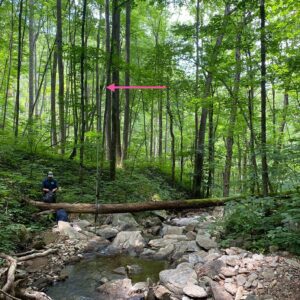
Installing an ultrasonic recording unit
North Carolina Wildlife Federation, National Parks Conservation Association, and other partners are working together to survey for at-risk bat species in some of the last remaining patches of old-growth forests and maturing second-growth forests in North Carolina. Our collective goal is to fill area-specific knowledge gaps to provide the best available information for future decision-making in forest management and conservation efforts. To achieve this goal, we are deploying ultrasonic recording units at suitable locations within our study area – the Craggy Mountains – a 16,000 acre portion of Pisgah National Forest. The data will be analyzed using SonoBat – a U.S. Fish and Wildlife Service approved bat call analysis software.
This bat survey project alongside our avian diversity study will provide critical data to fill knowledge gaps in order to provide the best available information for future decision-making in forest management and conservation efforts.

Bat spectogram reading from ultrasonic recording unit
How you Can Help
- Plant native perennial and annual flowers and trees that will attract native insects – bat food! Specifically evening or night-blooming flowers, which attract nutritious bat food like moths and beetles. Provide permanent wet areas of habitat, supply water sources, and a consistent source of insects when possible.

Photo: Tricolored bat (Perimyotis subflavus) by Pete Pattavina, USFWS
- Install a bat house around your home, neighborhood, or agricultural property. North Carolina State University Cooperative Extension offers a construction and installation guide and Bat Conservation International offers tips for building, buying or installing bat boxes.
- Don’t tear down dead trees (as long as it’s safe to leave them up). Avoid roost sites, hibernation areas, and maternity colonies to avoid disrupting the bats.
- Limit pesticide use whenever possible; bats are natural pest controllers.
- Help conserve bat and other wildlife habitat, including upland, riparian and bottomland forests.
- Know what to do if you discover a bat family roosting in your home.
- Contact NABat to volunteer as a bat surveyor
- Stay up to date on developments in bat conservation in North Carolina and help educate others. Updates on bat management can be found directly in the N.C. Wildlife Resources Commission’s Wildlife Program’s Quarterly Reports.
- Please support conservation efforts like the proposed Craggy Mountains National Scenic Area to protect important summer breeding habitat for bats. To sign the petition, please visit the site HERE.
- Attend one of NCWF’s bat events through our statewide Community Wildlife Chapter network like the one hosted by NCWF Triad WILD! Chapter at Haw River State Park. Check out the story HERE.
Written by:

– Luke Bennett, NCWF Conservation Coordinator

– Dr. Liz Rutledge, NCWF VP of Wildlife Resources


